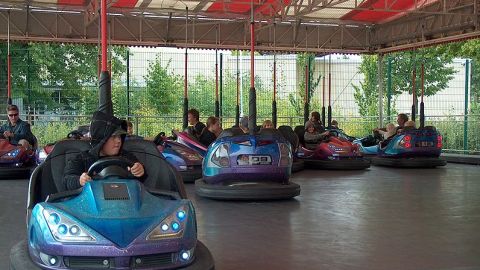Why We Don’t Do It in the Road

I’ve always been fascinated by the Pedestrian Do-Si-Do, that dance where you dodge to your left on the sidewalk to avoid colliding with a person walking toward you, and she dodges to her right, so there you both are, on a new collision course.
So you both smile, a little embarrassed, and she heads to her left while you head to your right, and suddenly this simple business of avoiding bumping into others seems impossible. It is one of the experiences that make a foreign place feel foreign, at least for me: in cities outside the U.S., I find myself crashing into other walkers more often, and I’ve always assumed it was because I was missing cues that natives learned as toddlers. How could such a simple thing go wrong? It’s like discovering you can’t remember how to stand, or to put one foot in front of the other.
The pedestrian do-si-do feels funny, but not a pleasant funny. I once did the dance left-right-left with a young black guy on Sixth Avenue in New York, who ended up exclaiming, “Goddamn white people don’t even know how to walk!”
I bet this dodging bit feels stupid because it tangles up the conscious mind in something it is no good for–something normally done outside awareness. After all, the striking thing about people’s behavior in large crowds is how 99 percent of the time we manage not to trip each other up. That’s a significant talent: Because you and I can walk by each other without a fracas, we don’t need to know one another as individuals. So members of our species, unlike other primates, can live peacefully in communities of thousands, or even millions, of individuals. Whatever lets us avoid the Pedestrian Do-Si-Do is part of what makes civilization possible.
But what is it? Lauri Nummenmaa, a cognitive psychologist, thinks it’s our talent for reading one another’s gaze. In a study published in this month’s Psychological Science, he and his colleagues describe an experiment in which they put volunteers in front of a simulated pedestrian on a screen, walking straight towards them. What would they do to avoid bumping into the guy? The answer was determined by the simulated stranger’s gaze: If he looked left, people said they would swerve right. That matched what their eyes had done while watching: If the animated pedestrian looked left, their own gaze went to the right, and vice versa.
It’s an interesting result in the context of gaze research, because it shows that people don’t automatically follow other people’s eyes to the object they’re regarding. On a city sidewalk, at least, people seem to have taught themselves that the important information in a stranger’s gaze is about the person, not the thing viewed. We take a leftward look as a signal that we should look, and move, the other way.
But of course it’s also interesting to relate this study to the Pedestrian Do-Si-Do. I can’t tell from the abstract if the experimental subjects were consciously aware of what they were doing. If they weren’t, it would be interesting to know how and at what age people learn to read stranger’s gazes, and if they’re ever aware of learning this skill. (We may learn it as young children and then forget that we did; but maybe gaze-reading, like language, is a lesson we learn “for free,” without conscious effort.)
Best of all, this is one of those theories that you can test in your own life. If gaze is the key to avoiding pedestrian-pedestrian collisions, then I should be able to avoid the Do-Si-Do, or an actual bumping, by a firm, clear look to the left. At least, if Nummenmaa is right, that should work better than glowering at some stranger and thinking, “Goddamn [old people, or French people, or tourists, or skateboarders, or whatever] don’t even know how to walk!”
Any other people out there want to test how their gaze affects others’ movements? If so, and if anything interesting turns up in your own sidewalk experiments, let us know in the comments.




